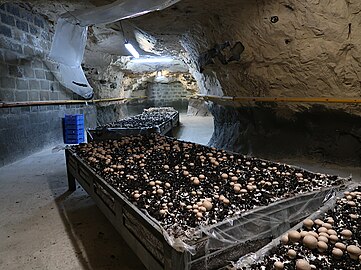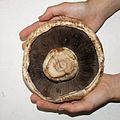Agaricus bisporus
| Agaricus bisporus | |
|---|---|

| |
| Scientific classification | |
| Domain: | Eukaryota |
| Kingdom: | Fungi |
| Division: | Basidiomycota |
| Class: | Agaricomycetes |
| Order: | Agaricales |
| Family: | Agaricaceae |
| Genus: | Agaricus |
| Species: | A. bisporus
|
| Binomial name | |
| Agaricus bisporus | |
| Synonyms | |
| |
| Agaricus bisporus saprotrophic | |
|---|---|
| Edibility is choice | |
Agaricus bisporus, commonly known as the cultivated mushroom, is a
A. bisporus has some deadly poisonous lookalikes in the wild.
Description
The pileus or cap of the original wild species is a pale grey-brown, with broad, flat scales on a paler background and fading toward the margins. It is first hemispherical before flattening out with maturity, and measures 5–10 centimetres (2–4 inches) in diameter. The narrow, crowded
Similar species
The common mushroom could be confused with young specimens of a group of lethal mushrooms in the Amanita genus referred to as destroying angels, but the latter may be distinguished by their volva or cup at the base of the mushroom and pure white gills (as opposed to pinkish or brown of A. bisporus).
A more common and less dangerous mistake is to confuse Agaricus bisporus with A. xanthodermus, an inedible mushroom found worldwide in grassy areas. A. xanthodermus has an odor reminiscent of phenol; its flesh turns yellow when bruised. This fungus causes nausea and vomiting in some people.
The poisonous European species Entoloma sinuatum has a passing resemblance but has yellowish gills, turning pink, and lacks a ring.
Taxonomy
The common mushroom has a complicated


Etymology
When immature and white, this mushroom may be known as:
- common mushroom
- white mushroom[11]
- button mushroom[11]
- cultivated mushroom[12]
- table mushroom
- champignon (French for mushroom) de Paris
When immature and brown, it may be known variously as:
- Swiss brown mushroom
- Roman brown mushroom
- Italian brown mushroom
- cremini (also crimini) mushroom[13][14]
- chestnut mushroom (not to be confused with Pholiota adiposa)
- baby bella[13]
When marketed in its mature state, the mushroom is brown with a cap measuring 10–15 cm (4–6 in).[14] This form is commonly sold under the names portobello,[14][15] portabella,[16] or portobella; the etymology is disputed.[14][15]
Distribution and habitat
This mushroom is commonly found worldwide in fields and grassy areas following rain, from late spring to autumn, especially in association with manure.
Cultivation
| Mushroom and truffle production – 2022 | |
|---|---|
| Country | Millions of tonnes |
| 45.4 | |
| 0.47 | |
| 0.32 | |
| 0.26 | |
| 0.24 | |
| World | 48.3 |
| Source: FAOSTAT of the United Nations[17]
| |
Production
In 2022, world production of mushrooms (including truffles) was 48 million tonnes, led by China with 94% of the total (table). Japan and the United States were secondary producers.
History
The earliest scientific description of the commercial cultivation of A. bisporus was made by French botanist
Originally, cultivation was unreliable as mushroom growers would watch for good flushes of mushrooms in fields before digging up the mycelium and replanting them in beds of composted manure or inoculating 'bricks' of compressed litter, loam, and manure. Spawn collected this way contained pathogens, and crops would be infected or not grow.[19] In 1893, sterilized, or pure culture, spawn was discovered and produced by the Pasteur Institute in Paris for cultivation on composted horse manure.[20]
| Nutritional value per 100 g (3.5 oz) | |
|---|---|
| Energy | 93 kJ (22 kcal) |
3.26 g | |
| Sugars | 1.98 g |
| Dietary fiber | 1 g |
0.34 g | |
3.09 g | |
Niacin (B3) | 23% 3.607 mg |
| Pantothenic acid (B5) | 30% 1.497 mg |
| Vitamin B6 | 6% 0.104 mg |
| Folate (B9) | 4% 17 μg |
| Vitamin B12 | 2% 0.04 μg |
| Vitamin C | 2% 2.1 mg |
| Vitamin D | 1% 0.2 μg |
| Minerals | Quantity %DV† |
| Iron | 3% 0.5 mg |
| Magnesium | 2% 9 mg |
| Phosphorus | 7% 86 mg |
| Potassium | 11% 318 mg |
| Sodium | 0% 3 mg |
| Zinc | 5% 0.52 mg |
| Other constituents | Quantity |
| Water | 92.45 g |
| †Percentages estimated using US recommendations for adults,[21] except for potassium, which is estimated based on expert recommendation from the National Academies.[22] | |
Modern commercial varieties of the common agaricus mushroom were originally light brown. The white mushroom was discovered in 1925 growing among a bed of brown mushrooms at the Keystone Mushroom Farm in
A. bisporus is cultivated in at least seventy countries worldwide.[10]
Nutrition
In a 100-gram serving, raw white mushrooms provide 93 kilojoules (22 kilocalories) of
While fresh A. bisporus only contains 0.2 micrograms (8 IU) of
Gallery
-
Ventral view of a portobello cultivar with a bisected stipe
-
Grilled portobello,arugula salad on a toasted baguette
See also
 Fungi portal
Fungi portal- List of Agaricus species
References
- ^ Imbach EJ (1946). "Pilzflora des Kantons Luzern und der angrenzen Innerschweiz". Mitteilungen der naturforschenden Gesellschaft Luzern (in German). 15: 5–85.
- ISBN 0-584-10324-7.
- ISBN 1-84400-040-0.
- JSTOR 3760617.
- ^ Callac P, Imbernon M, Guinberteau J, Pirobe L, Granit S, Olivier JM, Theochari I (2000). "Discovery of a wild Mediterranean population of Agaricus bisporus, and its usefulness for breeding work". Mushroom Science. 15: 245–252.
- ^ Cooke MC (1871). Handbook of British Fungi. Vol. 1. London: Macmillan and Co. p. 138.
- ^ "Species Fungorum – Species synonymy". Index Fungorum. CAB International. Archived from the original on 10 June 2011. Retrieved 21 January 2010.
- ^ Lange JE (1926). "Studies in the agarics of Denmark. Part VI. Psalliota, Russula". Dansk Botanisk Arkiv. 4 (12): 1–52.
- ^ Schäffer J, Møller FH (1939). "Beitrag zur Psalliota Forschung". Annales Mycologici (in German). 36 (1): 64–82.
- ^ a b Cappelli A. (1984). Fungi Europaei:Agaricus (in Italian). Saronno, Italy: Giovanna Biella. pp. 123–25.
- ^ a b "White Button". Fresh Mushrooms. Mushroom Council. n.d. Archived from the original on 29 February 2020. Retrieved 29 February 2020.
- ISBN 978-0-89815-169-5.
- ^ a b "Crimini". Fresh Mushrooms. Mushroom Council. n.d. Archived from the original on 7 August 2022. Retrieved 29 February 2020.
- ^ a b c d GourmetSleuth (11 November 2013). "Portobello (Portobella) Mushrooms". Gourmet Sleuth. Archived from the original on 10 January 2019. Retrieved 9 January 2019.
- ^ a b "portobello | Definition of portobello by Lexico". Lexico Dictionaries | English. Archived from the original on 31 August 2019. Retrieved 31 August 2019.
- ^ "Portabella". Fresh Mushrooms. Mushroom Council. n.d. Archived from the original on 29 February 2020. Retrieved 29 February 2020.
- ^ "Production of mushrooms and truffles in 2022, Crops/Regions/World list/Production Quantity/Year (pick lists)". UN Food and Agriculture Organization, Corporate Statistical Database (FAOSTAT). 2024. Retrieved 25 February 2024.
- ISBN 0-471-90435-X.
- ^ Genders 1969, p. 19
- ^ Genders 1969, p. 18
- ^ United States Food and Drug Administration (2024). "Daily Value on the Nutrition and Supplement Facts Labels". Retrieved 28 March 2024.
- )
- ^ Genders 1969, p. 121
- ^ Haytowitz DB (2009). "Vitamin D in mushrooms" (PDF). Nutrient Data Laboratory, US Department of Agriculture. Archived (PDF) from the original on 1 February 2021. Retrieved 16 April 2018.
- ^ "Mushrooms and vitamin D". Los Angeles Times. Archived from the original on 4 September 2011. Retrieved 23 August 2003.
- PMID 19281276.
Sources
- Genders, Roy (1969). Mushroom Growing for Everyone. London: Faber. ISBN 0-571-08992-5.
Further reading
- Benjamin, Denis R. (1995). Mushrooms: poisons and panaceas—a handbook for naturalists, mycologists and physicians. New York: WH Freeman and Company. ISBN 0-7167-2600-9.






